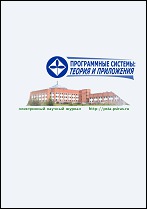|
Artificial intelligence and machine learning
The use of distributed computing in domain modeling in universal syllogistics
Yu. M. Smetanin
Udmurt State University, Izhevsk, Russia
Abstract:
We consider the algorithmic aspects of calculations in the logical-semantic models of universal syllogistics $L_{S_{2}}$. This non-classical propositional logic is based on an algebraic system containing a Boolean algebra of sets and two relations between sets: $\subset$ and $=$. Its closest analogue is Aristotle's syllogistics, the model of which is an algebraic system with a Boolean algebra of sets and one relation $\subset$.
The disadvantage of syllogistics based on an algebraic system with a single relation $\subset$ is the ambiguity of the interpretation of their formulas and atomic judgments.
In this work, by a logical\=/semantic model of a subject area we understand the totality of the universal syllogistic formula $L_{S_{2}}$ and its semantic meaning, which is a finite set of non-negative integers.
We propose an algorithm for computing semantic value of a conjunctive well-constructed formula $L_{S_{2}}$, which has a high level of parallelism at the task level, at the data level, and at the level of algorithms realizing operations on constituent sets. Due to the peculiarities of union, intersection and complement operations over finite sets, all the processes of their computation and solution of subtasks occur at the bit level and, as a rule, are efficiently implemented in algorithmic languages. In the proposed algorithm, the transition to the bit level and back is realized by a set of software tools.
Key words and phrases:
syllogistics, discrete Venn diagrams, logical-semantic models, frontal algorithm, distributed computing.
Received: 29.02.2024
Accepted: 17.04.2024
Citation:
Yu. M. Smetanin, “The use of distributed computing in domain modeling in universal syllogistics”, Program Systems: Theory and Applications, 15:2 (2024), 87–112
Linking options:
https://www.mathnet.ru/eng/ps443 https://www.mathnet.ru/eng/ps/v15/i2/p87
|

| Statistics & downloads: |
| Abstract page: | 31 | | Full-text PDF : | 15 | | References: | 15 |
|




 Contact us:
Contact us: Terms of Use
Terms of Use
 Registration to the website
Registration to the website Logotypes
Logotypes








 Citation in format
Citation in format 